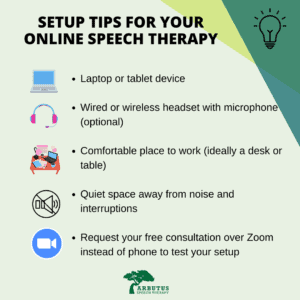Thanks to technology it has never been easier to connect with a Registered Speech-Language Pathologist. Online speech therapy sessions offer clients the same benefits of an in-person session while remaining safe at home. Popularized by the COVID-19 pandemic, online speech therapy is here to stay and for good reason! Learn more about online speech therapy below as well as what to expect and setup tips for your first session.
History of Online Speech Therapy
Online speech therapy (also called teletherapy or telepractice) has been nationally endorsed in Canada since 2006. Speech and Audiology Canada (otherwise known as SAC and previously known as CASLPA) acknowledged that with the advancement of technology, teletherapy was making it possible for people to access services they would otherwise not receive due to distance, cost, mobility, weather, or scheduling.
Since then, we have learned that when online speech therapy is done right, it is a highly effective therapy delivery method(1), can be used for a wide range of speech and language disorders(2-6), and is well-liked by parents and teachers(7).
Since the pandemic, much of the technology has improved, with a wealth of new online tools and therapy aids to help make online therapy sessions a highly effective and integrated experience. Many speech-language pathology assessments have been developed to be administered in an online setting and proven to have the same effectiveness as paper-based assessments administered in person.
What To Expect
Teletherapy is not “just a video call.” Video conferencing platforms such as Zoom and Theraplatform host a variety of applications that take video calls to the next level of interaction including:
- Screen sharing
- Whiteboard
- Annotation and touch screen
- Recording capabilities
Online Speech Therapy for Children
Online therapy has increased the enjoyment of speech therapy for many children as they love the online speech and language reinforcement activities such as interactive board games, making virtual pizzas, and squishing bugs with the press of a button.
Online speech therapy for children also makes it easier for children and parents to fit Speech Therapy in after school without requiring travel time to a clinic. While some goals are better worked on in-person, for most children, online therapy has similar efficacy to in-person while offering more convenience.
Online Speech Therapy for Adults
For Adults, online speech therapy has made it more available and convenient for them to work on their goals while being able to fit it into their busy schedule. Adults working on Accent Modification or Professional Communication appreciate the easy recording and review features that are built into online platforms that make doing homework more organized and simple.
What You’ll Need
Teletherapy is convenient, but of course you’ll need access to a device that can connect to the internet. Families and individuals can use laptops, desktop computers, tablets, and even smartphones.
Your device will need to have video and audio capabilities so your therapist can see and hear you, and your child can see and hear them. Ideally, that means a suitable webcam and a wired or wireless headset that can provide clear audio and microphone input.
A quiet, comfortable space is recommended, and the most ideal setup is sitting at a table or desk. But, as long as your speech therapist has a clear view of you or your child’s face, sitting on the couch or the floor works too.
It is recommended that a parent or caregiver sits with the child (especially younger children) so they can help with setup and any technical problems that may pop up, especially for the first online speech therapy session.

Other Benefits
Online sessions can provide more flexibility in the timing and frequency of your speech therapy sessions. For some speech and language concerns, more frequent sessions can help achieve and maintain results faster.
Teletherapy has helped families and individuals continue their speech therapy programs due to measures in place to protect us against COVID-19. However, the effectiveness, convenience, and engagement of online sessions has convinced many families to make this a permanent shift in the way they receive speech therapy.
Families appreciate the ease and flexibility of online speech therapy sessions as it reduces travel time and is available from anywhere in BC. It can also help cut down on missed sessions due travel, mild colds, or other things that might get in the way of an in-person appointment.
Overall, online speech therapy has proven to be popular with adults and families who are looking for a convenient and versatile approach to their speech therapy.
Beyond the Pandemic
Like many changes in the workplace over the last 4 years, online speech therapy rose in popularity during 2020 out of necessity, but it has endured beyond the pandemic to become a common preference for many families and individuals. Now, rather than the decision being made based on avoiding contact, it’s more of a family decision related to convenience and scheduling.
Questions?
Arbutus Speech Therapy offers both online therapy and in-person options. If you are are considering speech therapy services for yourself or your child, but aren’t sure if teletherapy is right for you, send us an email, give us a call or book a free consultation online and we would be happy to discuss your options.

Sources:
- Bernie, E. (2019). Critical Review: What is the efficacy of a telepractice service delivery model when compared to traditional on-site therapy for school-aged children receiving speech sound intervention (SSI)?.
- Waite, M. C., Cahill, L. M., Theodoras, D. G., Busuttin, S., & Russell, T. G. (2006). A pilot study of online assessment of childhood speech disorders. Journal of Telemedicine and Telecare, 12(3_suppl), 92-94.
- Parmanto, B., Pulantara, I. W., Schutte, J. L., Saptono, A., & McCue, M. P. (2013). An integrated telehealth system for remote administration of an adult autism assessment. Telemedicine and e-Health, 19(2), 88-94.
- Carey, B., O’Brian, S., Onslow, M., Packman, A., & Menzies, R. (2012). Webcam delivery of the Camperdown Program for adolescents who stutter: A Phase I trial. Language, Speech, and Hearing Services in Schools.
- Waite, M. C., Theodoros, D. G., Russell, T. G., & Cahill, L. M. (2010). Assessment of children’s literacy via an internet-based telehealth system. Telemedicine and e-Health, 16(5), 564-575.
- Halpern, A. E., Ramig, L. O., Matos, C. E., Petska-Cable, J. A., Spielman, J. L., Pogoda, J. M., … & McFarland, D. H. (2012). Innovative technology for the assisted delivery of intensive voice treatment (LSVT® LOUD) for Parkinson disease. American Journal of Speech-Language Pathology.
- Crutchley, S., & Campbell, M. (2010). Telespeech therapy pilot project: Stakeholder satisfaction. International Journal of Telerehabilitation, 2(1), 23.

